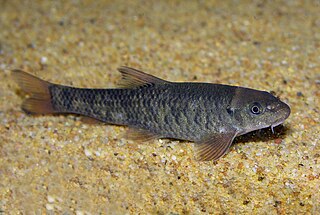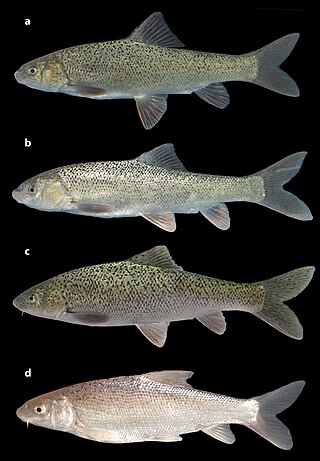
The red garra, also known as the doctor fish or nibble fish, is a species of cyprinid that is native to a wide range of freshwater habitats in subtropical parts of Western Asia. This small fish typically is up to about 14 centimeters in total length, but locally individuals can reach as much as 24 cm (9.5 in).
Caecocypris basimi, the Haditha cavefish, is a species of cyprinid fish endemic to Iraq, only occurring in aquifers near Haditha. It is found in an underground sinkhole directly under a shrine the only way to access which is a well 5m below the shrine. This cavefish is the only member of its genus. The species is classed as Critically endangered, possibly extinct, by the IUCN, as there have been no records since 1983 despite a comprehensive survey in 2012. The primary threat is water extraction, which has lowered the groundwater level. It is placed as one of the top 10 lost freshwater fishes to be found.

Garra is a genus of fish in the family Cyprinidae. These fish are one example of the "log suckers", sucker-mouthed barbs and other cyprinids commonly kept in aquaria to keep down algae. The doctor fish of Anatolia and the Middle East belongs in this genus. The majority of the more than 160 species of garras are native to Asia, but about one-fifth of the species are from Africa.
Garra ghorensis, the Jordanian log sucker or Dead Sea garra, is a species of ray-finned fish in the family Cyprinidae. It is native to Israel and Jordan, although it is no longer found in Israel. Its natural habitat is freshwater springs. It is threatened by habitat loss.
Garra kemali is a species of cyprinid fish, which is found only in Turkey, in swamps and freshwater lakes. It is threatened by a habitat loss.
Garra nana is a ray-finned fish species in the family Cyprinidae. It is found in Israel, Jordan and Syria. Its natural habitats are freshwater rivers, lakes and ponds of the Barada and Jordan River drainage basins, as well as the Kishon River. This bottom-dwelling fish is often overlooked, as it is small and prefers to hide among stones and water plants. It is an omnivore which feeds on aufwuchs. The species was previously placed in the genus Hemigrammocapoeta. It reaches up to 12 cm (4.7 in) in total length.
Garra typhlops, also known as the Iran cave barb is a species of ray-finned fish in the family Cyprinidae. It is endemic to caves in Iran. Like other cave-adapted fish, it is blind and lacks pigmentation.
Eidinemacheilus smithi, also known as the Zagroz blind loach, is a species of loach in the family Nemacheilidae. This cavefish is endemic to an aquifer in the Karun River drainage in the Zagros Mountains of Iran.
Egirdira is a monospecific genus of ray-finned fish belonging to the subfamily Leuciscinae, its only species is Egirdira nigra, or the yag baligi, is a species of freshwater fish in the family Cyprinidae. It is found only in Turkey, in tributaries of Lake Egridir in Central Anatolia. It is considered an Endangered (EN) since 2013, an improvement from Critically Endangered (CR) which was the status between 1996 and 2006.

Cavefish or cave fish is a generic term for fresh and brackish water fish adapted to life in caves and other underground habitats. Related terms are subterranean fish, troglomorphic fish, troglobitic fish, stygobitic fish, phreatic fish, and hypogean fish.
The Sellal bleak is a species of ray-finned fish in the genus Alburnus. It can be found in the drainage basins of the Queiq River and the Tigris–Euphrates river system in Iran, Iraq, Syria and Turkey. A recent study has found that Alburnus mossulensis was probably a synonym of Alburnus sellal.
Garra tibanica is a species of ray-finned fish in the genus Garra.
Garra variabilis is a species of ray-finned fish in the genus Garra from Lebanon, Turkey, Syria and Iraq.
Capoeta ekmekciae, the Grusinian scraper is a kind of freshwater cyprinid fish from Turkey. It is known exclusively from the Çoruh River. It was described as a separate species in 2006.

Paracapoeta erhani, also known as the Ceyhan scraper or Seyhan scraper, is a Turkish species of freshwater cyprinid fish in the genus Paracapoeta.
Garra elegans, previously Hemigrammocapoeta elegans, is a species of cyprinid fish. It is a benthopelagic freshwater species endemic to the Euphrates – Tigris basin in Western Asia.

The Black Sea tadpole-goby is a species of goby native to the basin of the Black Sea. Found in the Gulf of Tendra and limans of the north-western Black Sea, lakes of the Danube Delta. In the rivers of the Black Sea basin: Danube up to Iron Gate dam, Dniester up to Tighina, Dnieper up to Kyiv, Southern Bug. This species is mostly a denizen of fresh and slightly brackish bodies of water, preferring rivers and deltas, limans and coastal lakes. This fish can reach a length of 15 centimetres (5.9 in) TL.
Gymnocephalus ambriaelacus is a species of freshwater ray-finned fish, a ruffe, from the family Percidae which is endemic to Lake Ammersee, in the upper Danube basin in southern Germany. This species can reach a length is 11.7 centimetres (4.6 in) (SL). The species is classified as Critically Endangered as its population is declining following the introduction of the ruffe. Some authorities suggest that this taxon may be synonymous with the Balon's ruffe.
Garra jordanica is a species of ray-finned fish in the family Cyprinidae. This small fish, up to 10 cm (4 in) in standard length, is found in the northern Dead Sea basin, including the Jordan River system and Lake Kinneret, in Israel, Jordan and Syria. Populations in the coastal rivers of Kishon, Daliyya, and Taninnim have not been studied in detail, but may also be this species. In the past all these populations were included in G. rufa. Since the "G. rufa" seen in the aquarium and spa trade mostly are of Israeli origin, this leads to questions over their true identity. In the southern Dead Sea basin G. jordanica is replaced by the much rarer G. ghorensis.
Silurus triostegus, the Mesopotamian catfish, is a species of catfish found in Iran, Iraq, Syria, and Turkey.




